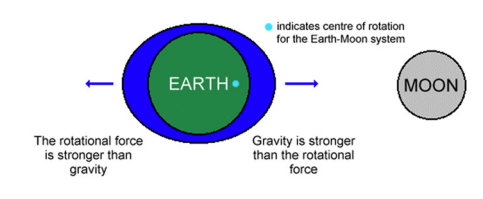Tides are caused by the effect of gravity in the Earth-Moon-Sun system, and the movement of those three bodies. Consider just the Moon for a minute, and imagine the Earth completely covered in water. There would be two bulges of water - one towards the Moon and another on the opposite side.
The rise and fall in sea-level is caused by the Earth rotating on its axis underneath these bulges of water. There are two tides a day because it passes under two bulges for each rotation (24 hours). This is called the lunar tide.

The Sun also creates two bulges of water called the solar tide - this is
about a third the size of the lunar tide.
Two Bulges? What causes the one on the side away from the Moon?
Most people think the Moon rotates round the Earth. In reality, the Earth and the Moon rotate about a common centre just inside the Earth's surface (indicated by the light blue dot on the diagram). At this common centre, the two forces acting: gravity towards the Moon and a rotational force away from the Moon are perfectly in balance.
They have to be otherwise the Earth and Moon would not stay in this orbit. The 'tide-generating' force is the difference between these two forces. On the surface of the Earth nearest the Moon, gravity is greater than the rotational force, and so there is a net force towards the Moon causing a bulge towards the Moon. On the opposite side of the Earth, gravity is less as it is further from the Moon, so the rotational force is dominant. Hence there is a net force away from the Moon. It is
this that creates the second bulge away from the Moon. On the surface of the Earth, the
horizontal tide generating forces are more important than the vertical forces in generating the tidal bulges
